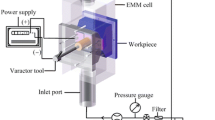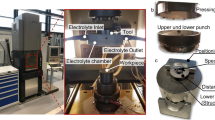Abstract
Fabricating microstructure arrays on non-planar workpiece surfaces poses significant challenges. In this paper, we propose a novel electrochemical machining process for creating micropit arrays on such surfaces using a rolling device equipped with linear cathode and soft mask. This process employs a rotary electrochemical etching method to fabricate the microstructures, addressing the limitations of traditional mask electrochemical machining, such as the inability to achieve large-scale production and difficulties in preparing curved surfaces. A set of electrolytic systems with the rolling device was constructed to machine micropit arrays on various surfaces of the metal workpieces. Numerical simulations were conducted to investigate the evolution of the electric field distribution and the variation of micropit profiles over time in the machining area, and it was determined that electrolytic machining occurs only at the micropits closest to the linear cathode When the ratio between the dimensions of the linear cathode and the mask hole is 1:3. Experimental tests were performed on the surface of a 304 stainless steel workpiece using a 10% NaNO3 electrolyte and a 0.1 mm electrode gap. The results demonstrated that micropit arrays could be successfully machined on the plane, inner and outer surface of the workpiece. Under an applied voltage of 10.5 V and a workpiece rotating speed of 0.2 r/min, the diameter of the machined micropit was 421.55±18.75 μm, the depth was 70.2±4 μm, the average etch factor (EF) was 1.16, and the roughness of the micropit was 0.625±0.205 μm, which suggested that the machined micropit arrays have high precision and uniformity. These results indicate that the machined micropit arrays exhibit high precision and uniformity. This study presents a promising strategy for high-precision batch machining of micropit arrays on both planar and curved surfaces of workpieces.
















Similar content being viewed by others
Data availability
Not applicable.
Code availability
Not applicable.
References
Lu Y, Xu WJ, Song JL, Liu X, Xing YJ, Sun J (2012) Preparation of superhydrophobic titanium surfaces via electrochemical etching and fluorosilane modification. J App Surf Sci 263:297–301. https://doi.org/10.1016/j.apsusc.2012.09.047
Song JL, Xu WJ, Liu X, Lu Y, Wei ZF, Wu LB (2012) Ultrafast fabrication of rough structures required by superhydrophobic surfaces on Al substrates using an immersion method. Chem Eng J 211:143–152. https://doi.org/10.1016/j.cej.2012.09.094
Xu WJ, Zhao Y, Sun J, Hu K, Song JL (2013) Experimental study of super-hydrophobic surfaces obtained on steel matrix by brush plating technique. J Chin Mech Eng 24(1):5–9. https://doi.org/10.3969/j.issn.1004-132X.2013.01.001
Hao XQ, Sun PC, Xiao SN, Yang YF, Li L (2020) Tribological performance of surface with different wettability under ball-on-disc test. J Appl Surf Sci 501:144228. https://doi.org/10.1016/j.apsusc.2019.144228
Wang LL, Zhao XT, He MX, Zhang W (2021) Effect of micro grooves on lubrication performance of friction pairs. J Meccanica 56(2):351–364. https://doi.org/10.1007/s11012-020-01295-y
Boidi G, Tertuliano IS, Profito FJ, de RW (2020) Effect of laser surface texturing on friction behaviour in elastohydrodynamically lubricated point contacts under different sliding-rolling conditions. J Tribol Int 149:105613–105613. https://doi.org/10.1016/j.triboint.2019.02.021
Su BB, Huang LR, Huang W, Wang XL (2018) Observation on the deformation of dimpled surface in soft-EHL contacts. J Tribol Int 119:521–530. https://doi.org/10.1016/j.triboint.2017.11.029
Cui XB, Li YH, Guo JX, Ming PM (2021) Effects of bio-inspired integration of laser-induced microstructure and coated cemented carbide on tool performance in green intermittent turning. J Manuf Process 65:228–244. https://doi.org/10.1016/j.jmapro.2021.03.036
Cui XB, Li YH, Guo JX, Guo Q (2022) Transport behaviors and green interrupted cutting performance of bio-inspired microstructure on Al2O3/TiC composite ceramic surface. J Manuf Process 75:203–218. https://doi.org/10.1016/j.jmapro.2022.01.002
Song JL, Huang WB, Liu JY, Liu H, Lu Y (2018) Electrochemical machining of superhydrophobic surfaces on mold steel substrates. J Surf Coat Technol 344:499–506. https://doi.org/10.1016/j.surfcoat.2018.03.061
Zhan SD, Zhao YH (2020) Plasma-assisted electrochemical machining of microtools and microstructures. Int J Mach Tools Manuf 156:103596. https://doi.org/10.1016/j.ijmachtools.2020.103596
Wang J, Xu ZY, Wang JT, Xu ZL, Zhu D (2021) Electrochemical machining of blisk channels with rotations of the cathode and the workpiece. Int J Mech Sci 208:106655–106655. https://doi.org/10.1016/j.ijmecsci.2021.106655
Zhai K, Du LQ, Wang SX, Wen YK, Liu JS (2020) Research on the synergistic effect of megasonic and particles in through mask electrochemical etching process. J Electrochimica Acta 364:137300–137300. https://doi.org/10.1016/j.electacta.202037300
Chen XL, Fan GC, Lin CH, Dong BY, Guo ZN, Fang XL, Qu NS (2020) Investigation on the electrochemical machining of micro groove using masked porous cathode. J Mater Process Technol 276:116406–116406. https://doi.org/10.1016/j.jmatprotec.2019.116406
Sun YK, Ling SY, Zhao DY (2020) Through-mask Electrochemical Micromachining of Micro Pillar Arrays on Aluminum. J Surf Coat Technol 401:126277–126277. https://doi.org/10.1016/j.surfcoat.2020.126277
Wu M, Liu JW, He JF, Chen XL, Guo ZN (2020) Fabrication of surface microstructures by mask electrolyte jet machining. Int J Mach Tools Manuf 148:103471–103471. https://doi.org/10.1016/j.ijmachtools.2019.103471
Zhu D, Qu NS, Li HS, Zeng YB, Li DL, Qian SQ (2009) Electrochemical micromachining of microstructures of micro hole and dimple array. J CIRP Ann-Manuf Technol 58(1):177–180. https://doi.org/10.1016/j.cirp.2009.03.004
Chen XL, Qu NS (2016) Li Hansong, Xu ZY (2016) Electrochemical micromachining of micro-dimple arrays using a polydimethylsiloxane (PDMS) mask. J Mater Process Technol 229:102–110. https://doi.org/10.1016/j.jmatprotec.2015.09.008
Ming PM, Zhou WH, Zhao CH, Zhou HM, Qin G (2016) Zhang XM (2016) Active through-mask electrochemical machining with its interelectrode gap filled with flexible porous material. J Sci Sin Technol 46(10):1005–1015. https://doi.org/10.1007/s00170-017-0541-5
Ming PM, Zhao CH, Zhang XM, Li XC, Ge Q, Yan L (2018) Investigation of foamed cathode through-mask electrochemical micromachining developed for uniform texturing on metallic cylindrical surface. Int J Adv Manuf Technol 96(9):3043–3056. https://doi.org/10.1007/s00170-018-1755-x
Shen JW, Ming PM, Zhang XM, Niu S, Xia YK, Zhang YY, Wang W, Li DD (2022) Fabrication of massive metal microstructures by rotating through-mask electrochemical transferring technology. J Mech Eng 58(11):295–307. https://doi.org/10.3901/JME.2022.11.295
Wang DY, Zhu ZW, Wang NF, Zhu D, Wang HR (2015) Investigation of the electrochemical dissolution behavior of Inconel 718 and 304 stainless steel at low current density in NaNO3 solution. Electrochim Acta 2015(156):301–307. https://doi.org/10.1016/j.electacta.2014.12.155
Funding
This work is supported by the National Natural Science Foundation of China (No. 51105134), China Postdoctoral Science Foundation (No. 2020M682289), Key Research Development and Promotion Special Project (Science and Technology) of Henan Province (No. 232102221020), and Plan of Key Scientific Research Projects of Colleges and Universities in Henan Province (No. 21A460001).
Author information
Authors and Affiliations
Contributions
Ge Qin: conceptualization, methodology, writing—original draft, writing—review and editing, visualization, and supervision. Meng Li: investigation, visualization, writing—review and editing, and conceptualization. Lei Han: investigation and writing—original draft. Pingmei Ming: investigation and writing—review and editing. Xinmin Zhang: investigation and resources. Shen Niu: resources, conceptualization, methodology, and writing—review and editing. Liang Yan: writing—review and editing, project administration, and conceptualization. Xingshuai Zheng: writing—review and editing, project administration, and conceptualization. Shiwei Li: writing—review and editing, conceptualization, supervision, and funding acquisition.
Corresponding author
Ethics declarations
Ethics approval
Not applicable.
Consent to participate
Not applicable.
Consent for publication
All authors have read and agreed to the published version of the manuscript.
Conflict of interest
The authors declare no competing interests.
Additional information
Publisher’s note
Springer Nature remains neutral with regard to jurisdictional claims in published maps and institutional affiliations.
Rights and permissions
Springer Nature or its licensor (e.g. a society or other partner) holds exclusive rights to this article under a publishing agreement with the author(s) or other rightsholder(s); author self-archiving of the accepted manuscript version of this article is solely governed by the terms of such publishing agreement and applicable law.
About this article
Cite this article
Qin, G., Li, M., Han, L. et al. Electrochemical machining process for micropit arrays using a rolling device with a linear cathode and a soft mask. Int J Adv Manuf Technol 131, 2653–2665 (2024). https://doi.org/10.1007/s00170-023-11968-z
Received:
Accepted:
Published:
Issue Date:
DOI: https://doi.org/10.1007/s00170-023-11968-z




